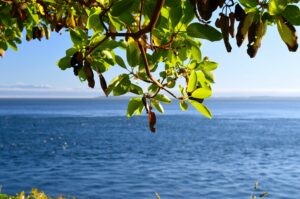Most people who visit the islands want to see the Orca whales. Films such as “Free Willie” have made children everywhere aware of the Orcas. The film was shot in part on Lopez Island. For the best whale watching, come to visit between April and September and view from the land or a boat that is next to the west side of San Juan Island as this is the feeding path of the whales which travel up and down this corridor, sometimes close in to the kelp beds and sometimes further out. Bring your binoculars!
The San Juans has a “resident” pod of Orcas, called J-Pod. J pod spends its spring, summer and fall months in the Puget Sound, Strait of Juan de Fuca and the southern Georgia Strait. J-Pod is part of the southern resident killer whales community, also called the Orcas of the Salish Sea. We prefer to call the whales Orcas rather than “killer” whales. The larger community, dubbed, “southern resident killer whales” (SRKW) represent the smallest of four resident communities. It is the only orca whale population listed as endangered and it is currently protected under the Endangered Species Act. The clan consists of 3 pods (J, K, L) with several matrilines within each pod. A matriline is a female line of descent. There are approximately 78 individuals that make up this small population. Each one is identifiable by their particular dorsal fin markings and is called by a number. In 2012, two calves were born, one in J pod and one in L. One calf was born in 2013 but he did not survive. In 2014, L120 was born into L pod but didn’t survive more than a month.
The good news is that very recently in late 2014, a new calf was spotted by its distinctive pinkish color off of Pender Island in British Columbia. Named J50, it is a girl! The calf was seen swimming alongside 42-year-old J16 (Slick). Slick was not expected to be carrying a calf due to her advanced age. No other female has given birth at over 42 years of age in the four decades of demographic field studies of the Southern Resident orcas. This led to suspicions that maybe Slick was not the mother, but since the baby seems to be thriving, it looks like she is. Another very special member of the pod is estimated to have been born around 1911, J2 is about 103 years old. It is amazing what we are learning about these wonderful creatures.
San Juan Island in particular has several points of interest for the whale lover. First, just drive to the West side of the island and you will be able to pull off the road and look for whales. Much of this property has been bought with land bank funds and are for public use. Go out at sunset with your picnic dinner and make an event of it. There is also Whalewatch Park, with parking and a lighthouse where they collect data about the whales. In town you will find the Whale museum with its displays and shop. If you are not content to watch from the land, you may want to venture out in a whale watch boat. San Juan Island and its whales welcome you.

Another very special member of the pod is estimated to have been born around 1911, J2 is about 103 years old




